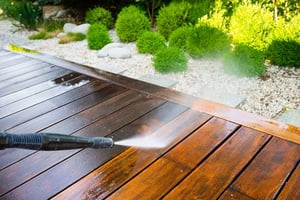Having a deck at your restaurant or place of business is a great way to attract customers and increase employee morale during those warmer months. But a deck also means that there are things you have to do to ensure it remains clean, sanitary, and safe. One of the best ways to do so is to go through a complete refinishing, but this presents its own challenges, especially on an industrial level. Additionally, the steps you’ll need to take also depends on what the deck is made of; concrete, wood, metal, or composite.
When refinishing your business’ deck, you can’t afford to have the deck closed for more than one or two days, which means you need to ensure that the refinishing method is fast and efficient. Thankfully, there are several ways that you can make sure that your deck will look like new and be finished without affecting your business too much.
The first step, no matter what your deck is made of, is to clean it thoroughly. That means any excess debris such as dirt or leaves needs to be removed. Once the deck has been swept, the next steps depend on what the deck is made of.
Concrete Decking: Sealed concrete usually doesn’t need refinishing for many years due to the durable nature of the sealant. However, if your deck is becoming discolored or stained, you can have the cement pressure washed. When pressure washing a cement deck, you need to ensure that the pressure is at least 3000 psi with a flow of at least 4 gallons per minute.
Another option if your concrete deck is beginning to wear down is to apply an overlay. The best part about an overlay is that you can have it stamped to replicate nearly any surface. Keep in mind that if the existing concrete deck is beginning to settle because of freezing, it may need a complete replacement.

Wood Decking: Pressure washing a wooden deck is entirely feasible, but you have to be extra careful with the pressure. Too much pressure will cause the boards to become etched and ruined. Too little, and your deck becomes wet without any cleaning.
In general, a hardwood deck pressure wash should never exceed 1500 psi, and a softwood deck (which is rarely found in business applications) should never be washed with more than 600 psi.
Once the wood deck is pressure washed, you’ll want to have it sanded. The best way to sand is to use an industrial orbital sander which uses large discs of sand paper. Using an increasingly finer grit will ensure that your deck will be properly prepared for the staining process.
When you select a stain for your company’s deck, you need to ensure that you don’t use a polyurethane sealant, as UV rays will cause it to break down. Staining a deck as part of the refinishing process is the most labor-intensive part because the individual rails and balustrades will need to be hand applied. Before applying the stain, ensure that at least 48 hours have passed since the last time the deck was wet. Water will prevent the stain from being properly absorbed into the wood of the deck.
Composite Decks: These decks are made from a combination of wood and plastic pressed together to form individual boards. The manufacturing of these types of decks has come a long way, and because of the material’s inherent resistance to insect, moisture, and weather damage, they can last up to 30 years.
Sometimes, however, because of UV damage, composite decking can discolor or become mottled. In these cases, you can easily restore the deck’s original look. First, clean the entire deck using a pressure washer with at least 3100 psi. If you use a detergent, make sure that you rinse it completely. After that, you can apply a specific composite deck stain that will restore the look of your original deck. Most composite deck stains will handle moderate foot traffic and last about 2 years.

Metal Decks: Metal decks are easy to take care of. The main danger for this type of deck is rust. If the deck does get rusted, you’ll need to remove the rust with a grinder. Use a metal grinding tool or sandpaper designed for metal. Start with a low grit (usually about 80) and progress upward until you reach about 150 to keep the area smooth.
Once all of the rust is removed, you need to apply a primer coat followed by a specific metal paint. This primer and paint combination will provide your deck protection against rust. Once your deck reaches about three layers, you’ll want to have those coats sanded down to bare metal and apply a new base coat of primer.
Of course, the best way to avoid costly refinishing is to make sure you’re taking care of your deck properly. One of the primary reasons that decks require refinishing is because of easily preventable damage. Here are four things you should check to maximize your deck’s longevity.
- Seasonal Cleaning – Each season brings its own unique challenges to keeping your deck in top shape. Winter brings salt, sand, and other anti-slip materials that can be tracked onto your deck. Spring and summer introduce fertilizer, leaves, and lawn debris that need to be cleaned and washed from your deck.
- Drainage and Splash Testing – Decks need adequate drainage in order to remain in good condition. Every few months, you should be checking your deck to ensure that the surface allows for runoff and no standing water will remain. If you aren’t sure if a wooden deck needs refinishing, you can do a splash test.This is where you take a glass of water and splash it on the deck; if the deck needs to be refinished, then the water will soak into the wood and make it darker. If the water puddles on the surface, your deck will be good for another few months.
- Inspect for Mold or Mildew – a visual inspection of your deck will reveal if there are any specific trouble spots. The presence of mold or mildew on a wooden deck indicates excessive moisture and requires special cleaning and repair before you refinish the deck. On composite or metal decking, the presence of mold or mildew means that the area has excessive moisture which can indicate drainage issues. Make sure that all of the contaminants are cleaned from the deck before you refinish anything.
- Inspect Flashing and Electrical Sockets – The flashing on your deck is located where the deck meets the primary structure of your business. Usually, there is a section of metal that prevents moisture from seeping into and damaging the adjoining structure. You want to ensure that the flashing is undamaged and clean. Foreign debris can catch water, which can freeze and cause expansion and contraction damage to the deck.
- Supports and Balustrades – it is essential that you inspect the supports, railings, and balustrades on your commercial deck. Not only will this save you from a costly insurance settlement if a customer or employee is injured because of a faulty or damaged safety structure. Make sure that the posts aren’t damaged or that the concrete footings are still solid and undamaged.Depending on the material that these are made of, you should have them cleaned more frequently if only to maintain their appearance. Frequent proper cleanings will also help preserve their longevity.
Decks are great places for customers and employees to gather, but not if they are dirty or unsafe. Using these tips, you can ensure that your cleaning company is taking the proper steps to keep your decks in the best shape possible. Additionally, you’ll know when your deck needs refinishing to increase its longevity and preserve its value.



0 comments